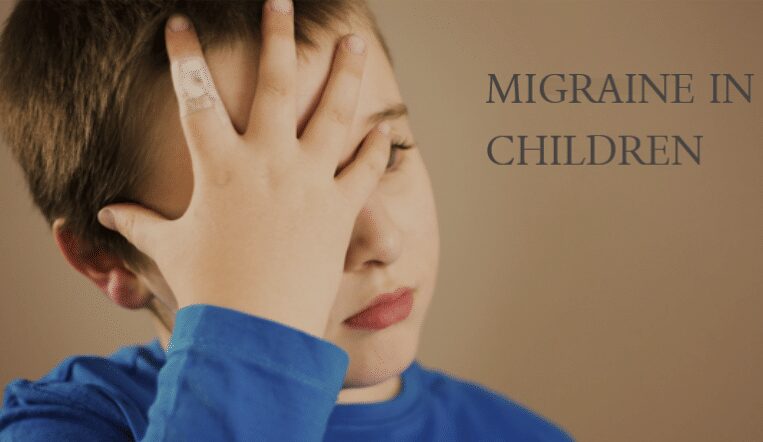Do children also get the same migraine as adults? Are the symptoms of migraine the same in children as in adults?
Spotting migraines in kids can be a tricky task and avoiding the signs can cause serious health issues.
Migraine awareness has become so common in adults that we can misunderstand children. A migraine headache is so much more than just a bad headache. It is a serious neurological disorder that leads to a throbbing pain that might severely affect your life.
What is a migraine headache?
A migraine is a continuous headache that can be moderate to severe and usually lasts from 2 hours to 2 days. It occurs twice or more times per month. This type of headache is often accompanied by nausea and sensitivity to light and sound.
Migraine can also occur in about 3% of children of age below 2-4 years, and 8% to 15% of teenage children.
Migraine can be seen more commonly in boys than girls in early childhood and before puberty. In adolescence, migraine affects young women more than young men. As adults, women are more prone to migraine than men. There are four phases of a migraine episode:-
- The Prodrome stage begins perhaps a day or two before the migraine headache with subtle symptoms like constipation, unexplained changes in mood, specific food cravings, etc.
- Aura: the prodrome stage is followed by the aura stage which is depicted by flashy or bright lights.
- Attack: In this stage, migraine attacks begin gradually and slowly become more severe. This phase is described as throbbing or pulsing pain on one side of the head.
- Postdrome: occurs post a migraine attack, characterized by an extreme feeling of exhaustion, weakness, and confusion that lasts a day.
Complicated migraines with neurological symptoms
- weakening of the eye muscles, keeping the eye in its normal position, and controlling its movement.
- Pain at the base of the skull as well as numbness, and tingling.
- Confusion and speech and language problems. This is called confusional migraine and may also occur after a minor head injury.
- uncontrolled vomiting that lasts about 24 hours and occurs every 60 to 90 days.
People who get migraine headaches are also more susceptible to certain health conditions such as :
- Heart diseases
- Sleep deprivation
- Hearing loss
- Depression
If you are also noticing the following sign and symptoms then proper health checkups and doctor consultations become mandatory.
What are the signs and symptoms of migraine?
symptoms of migraine can vary from body to body, common symptoms include:
- Throbbing or acute head pain- affecting the front or both sides of the head.
- Pale skin colour
- Irritable, moody
- Aura or Sensitivity to sound
- Sensitivity to light, distorted vision
- Loss of appetite
- Gastrointestinal -Nausea and/or vomiting.
What causes migraine attacks?
“abnormal” brain activity that affects nerve signaling or changes in blood vessels in the brain causes migraine.
Some of the migraine triggers that are continually reported include:
- bright lights
- severe heat, or other extremes in weather
- dehydration
- hormonal changes in people such as females at birth, like estrogen and progesterone fluctuations during menstruation, pregnancy, or menopause
- excessive stress
- loud sounds
- intense physical activity
- omitting meals
- changes in sleep patterns
- use of certain medications, like oral contraceptives or nitroglycerin
- Irritable smells
- certain triggered foods
- smoking
- alcohol use
- traveling
Remedies to treat migraine
Experts claim that there are no permanent treatments or solution for this disorder. However, the migraine can be treated by incorporating some actions that focus on relieving symptoms or preventing migraine attacks. If headache or pain are unbearable, it is always advisable to consult your healthcare professional for further medications to treat migraine.
Effective home remedies to help you manage migraine headaches effectively
- ice pack

A quick and easy home remedy for migraine headaches is an ice pack. Whether it’s your forehead, scalp, or even your neck an ice pack can deliver immediate pain relief.
- Apply peppermint oil

Peppermint oil is a chemical called menthol that not only works to relieve pain but also works to prevent further migraine episodes
- Ginger for nausea and pain

Ginger is another home remedy for relieving symptoms of migraine like nausea. Moreover, it also possesses pain-relieving elements.
- Yoga or breathing exercises

yoga, meditation, or breathing exercises can reverse migraine yoga Yoga can be a long-term preventative measure or management tool to reduce the intensity, duration, and frequency of migraine attacks. The incorporation of yoga in daily life can even help in stress management and improve overall vascular health.
Read More: Elon Musk will not lay off employees after acquisition of Twitter on October 28













